
views
Finding Your Story Idea

Develop your own experiences into a story. Your life is full of interesting experiences! Just think of all the times you’ve told friends or family members stories about yourself. One of these stories might make a great book! Turn your life stories into fiction using your imagination! Change the names of everyone involved, and add a few exciting incidents that didn’t really happen. For example, you could write a book inspired by your experiences at camp, about starring in a school play alongside your crush, or about the trials and tribulations you faced while trying out for a team.

Talk to your relatives about your family history. Historical events, especially if they’re personal, can be a great source of inspiration. Just as your life experiences are interesting, those of your relatives and ancestors are, as well. Ask your parents and grandparents to tell you their favorite family stories. Then, turn 1 of those stories into a book. You can write the story as non-fiction, meaning it’s a true story, or you can use your imagination to make it fiction. For example, you could write a book about how your grandparents reunited after World War II.

Write a book about an event or time period in history. You might insert your main character into an event that actually happened. Alternatively, you could just write about a character than lives in a time period you think is interesting. Think about historical events or periods you liked learning about in history class. Do some research about the period. For example, you might write a book that takes place in Ancient Egypt. You can create a realistic story set in a different time period, or you can use history to inspire a fantasy story.

Create a story based on an overheard conversation. You’ve probably read social media threads where the poster typed out a conversation they overheard, sometimes with added commentary. You could do something similar when writing your book! Listen to a conversation in a public place, then write a book about the people who are having it. Consider using this conversation as your first chapter. What happens next? Where will these characters end up?

Use your imagination to explore an interest of yours. You know that reading lets you get into someone else’s mind or travel to a new land. So can writing! Your book is a great opportunity to create a world all your own. Write a book about a character who shares your favorite hobby. Give your main character a talent you’ve always wanted to have. Write a book about your favorite fantasy creature, such as a vampire, mermaid, fairy, or elf. Base a book on a game you like to play.
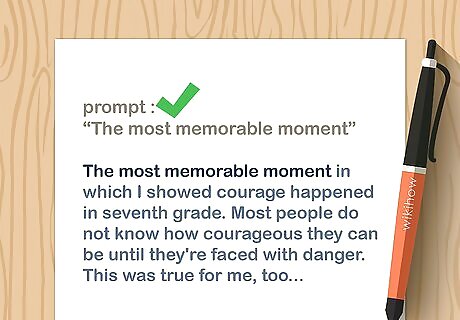
Try a writing prompt. You can find writing prompts online, or you could buy a book of prompts. There are even random prompt generators online that will provide you with a unique prompt! Prompts can give you fun ideas for your book. You could try combining two prompts to make something new. You can find a writing prompt generator here: https://thestoryshack.com/tools/writing-prompt-generator/
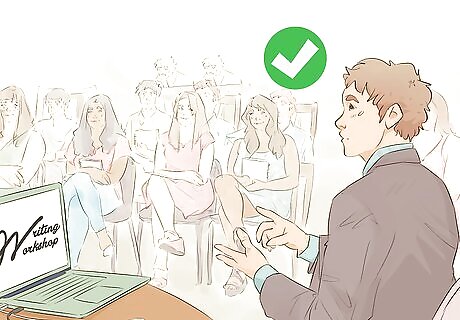
Take a creative writing class. Writing classes can help you learn more techniques for developing story ideas. In many cases, you'll learn about different templates that can help you with brainstorming. You'll also have the benefit of bouncing ideas off fellow writers. Look for a creative writing class at your school. You may also be able to find 1 at your local library or community center. If this isn't an option, you could enroll in an online class.
Plotting Your Story

Jot out a summary of your story idea. In some cases, this might be a synopsis of your book. However, you can also write out a 1 sentence concept for your book. Base your summary on the typical “blurb” you see on the back of a book. It usually introduces the main character, the book’s concept, and the conflict. For example, "Hazel can't believe she really scored the role of Juliet in the school play, but the best part is the guy playing her Romeo - Liam. Not only is Liam the coolest guy in drama club, he's also Hazel's crush. Can Hazel win the hearts of both the audience and Liam?"

Choose your genre. Your genre will determine a lot about your book. Your reader will expect your novel to follow the tropes of the genre you choose, so stick to what you’re familiar with. If you aren’t familiar with the genre you want to write, do some research to learn more about it. For example, a teen romance will focus on a relationship, while a sci-fi novel will focus on a futuristic scenario. In the example above, Hazel's story might fall in the genre of contemporary teen romance.
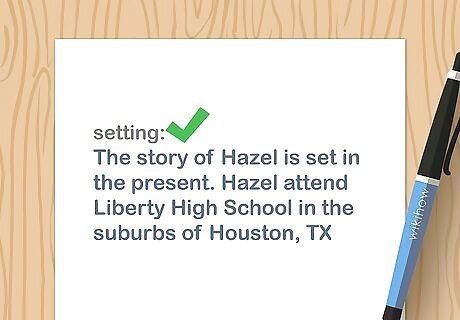
Establish your setting. Where and when does your story take place? It’s important to decide this early because it will influence how your characters behave, what they look like, the story’s environment, and the technology in the book. For example, a book set in the 1960s wouldn’t have cell phones. Also, society would be a lot different. Research your setting to learn more about it. You can also look at photos of it for inspiration! For Hazel's story, you might decide to set it in the present. She could attend school in the suburbs of Houston, TX.
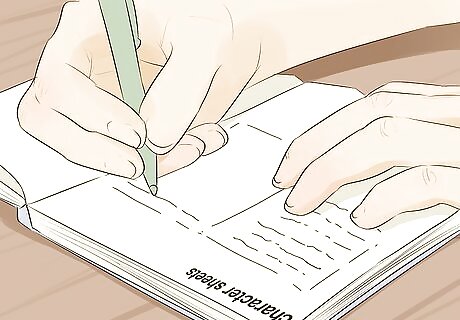
Create character sheets for your main and supporting characters. At the minimum, include a basic description of your character, as well as their traits, interests, and desires. It’s best to also include their character arc, which is what happens to them over the story. You can create your own character sheets, or you can use an online template. Develop backstories for your characters to help make them more complex. Make your character relatable to readers by giving them interests or traits your readers will share. For example, your character might be obsessed with the show Empire or might make electronic music in their bedroom. Here’s a great template to try: https://onestopforwriters.com/templates_worksheets
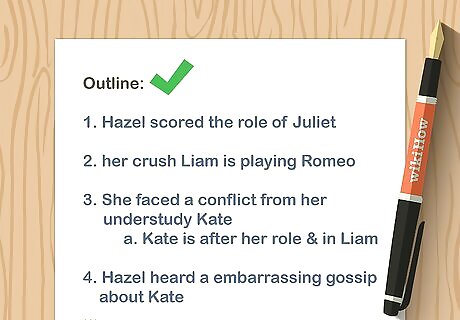
Outline the major events in your story, as best you can. You can always add more to your outline later! Right now, just focus on the major plot points, as well as any details you might have figured out. As ideas come to you, you can add them to the outline. Don’t worry if your outline is bare at first. You don’t need to know the whole story to get started. Just have a general idea about what might happen.

Use storyboarding if outlining doesn’t work for you. To do storyboarding, you simply write out your scene ideas on index cards, on separate sheets of paper, or in boxes. You can then put them in order and easily switch them around if you change your mind. Storyboarding works well for when you have an idea about what you want to happen but aren’t sure how your plot will go. Storyboarding also works well for visual people! You can even include pictures in addition to words.
Writing Your First Draft

Write your first draft quickly. Focus on just getting your words out on paper. Don’t worry if your writing is good. It’s normal for a first draft to need a lot of revision! Give yourself permission to write badly! Remember, you don’t have to show it to anyone until you’re ready. Later, you can revise what you’ve written to improve your writing.

Avoid reading over what you’ve written until you’ve finished. It’s tempting to go back over what you’ve written. You might want to evaluate its quality, improve problematic sentences, or add more to a scene. However, this makes it very hard to finish. The best way to reach the finish line is to keep going until you’re done.
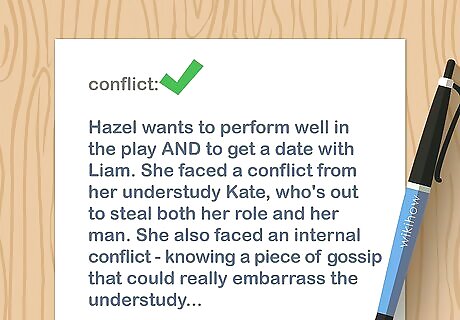
Make sure your story has a conflict. Set up your conflict in your first chapter, and build it throughout the book. In the climax, your conflict should reach its peak and be resolved. The end of your book will summarize a grain of truth your reader should take away. Your conflict could be internal or external. External conflicts might be person against person, person against nature, or person against society. For example, Hazel wants to perform well in the play AND to get a date with Liam. She might face an external person against person conflict from her understudy, who's out to steal both her role and her man. She may also face an internal conflict, such as knowing a piece of gossip that could really embarrass the understudy.
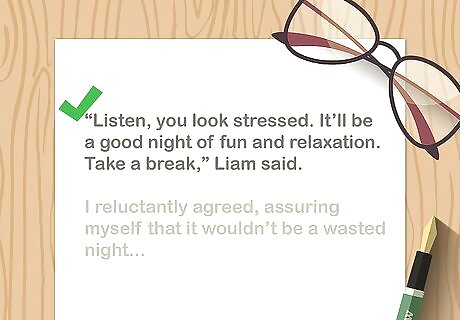
Incorporate dialogue when appropriate. Dialogue helps your story progress, and it helps develop your character. Use dialogue to advance your plot, not just to fill up the pages. For example, Hazel might talk to her best friend about knowing the piece of gossip. Similarly, Hazel might overhear a conversation where the understudy discloses her plans to steal Hazel's part.
Revising Your Draft

Set aside your manuscript for at least a week before reading it. Take a break from your manuscript so you can review it with fresh eyes. You need to take a break for at least a week, but it’s best to wait 2-4 weeks before you start editing it. This makes it easier to recognize problems in your work. You can read your manuscript on your computer or tablet, or you can print it out. As you read, mark typos you find so you can go back and fix them. Also, use a highlighter to mark passages you want to change, and make note of places you want to revise or develop.
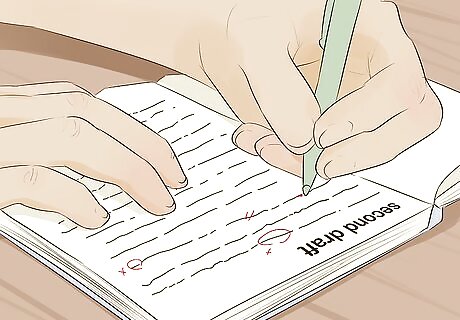
Rewrite parts of your book to improve it. Remember how your first draft was all about finishing? Well, this is the part of the writing process where you make it good! Use the notes you made while reading through your manuscript to fix the parts of your book that don’t work. Sometimes writers rewrite parts of their book multiple times, and that’s okay. Don’t feel like you have to get it perfect the first time.

Make sure your book follows Fretag’s triangle. This is a popular tool for storytelling. There are 5 parts, which allow you to set up a well-told story: Exposition: Introduce your characters and setting. (Hazel and her BFF try out for the school play, where they swoon over Liam and complain about the understudy.) Inciting incident: Hook the reader with an event that sets off your plot. (Hazel gets the part of Juliet, while Liam is Romeo.) Rising action: Build your story, moving to a crisis moment. (They all prepare for the show. Meanwhile, Hazel deals with the understudy.) Climax: Your story reaches its peak moment, which is often a crisis. (Hazel accidentally texts about the gossip in a group text. In retaliation, the understudy locks Hazel in the bathroom right before curtain call on opening night.) Falling action: Your story resolves. (After escaping the bathroom, Hazel realizes the understudy has gone on stage, but it's the mask scene, so no one sees her face. Hazel is able to tell their teacher what happened and take back her part.) Conclusion: Your story ends. (Hazel and Liam share a kiss on stage that's full of sparks. He asks her out after the show.)

Recruit a few beta readers to provide feedback. Beta readers are like practice readers. They read your book before you're totally done with it. Let your beta readers know that your book is in progress and that you’d like to improve the book using their opinions. You could ask for general feedback, or you could ask your beta readers to answer specific questions you have about the book. For example, “Is it believable that my character could do this?” or “Do I have enough description?” Choose readers who are part of your target audience. For example, if you’re writing a novel for teens, your friends’ opinions will be more important than your teacher’s.

Revise your book based on the feedback. Use the feedback you gathered from your beta readers to create your final draft. You might incorporate their suggestions, or you might stick with what you originally wrote. What matters is that you’re happy with the book you wrote!
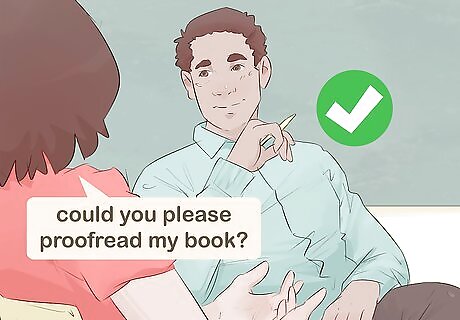
Ask a proofreader to review your book. You can hire someone to edit your book through a site like Thumbtack or Upwork, but you don’t have to go this route. As an easy alternative, get someone you know is knowledgeable about grammar and spelling to read your book and mark errors or typos. For example, you might ask your parent, older sibling, or teacher to read your book. Alternatively, you might have a friend who’s in honors English.


















Comments
0 comment